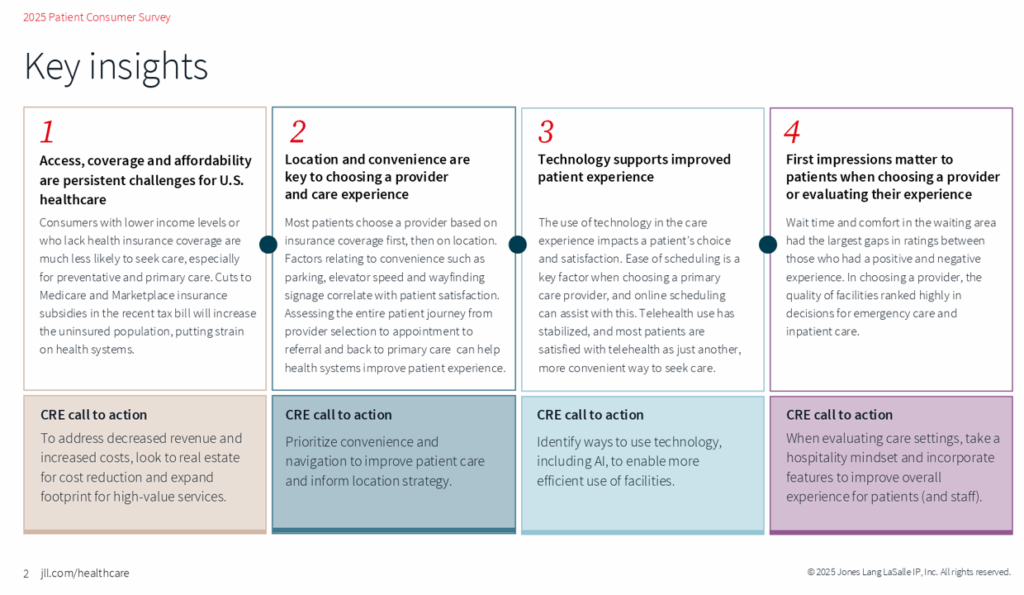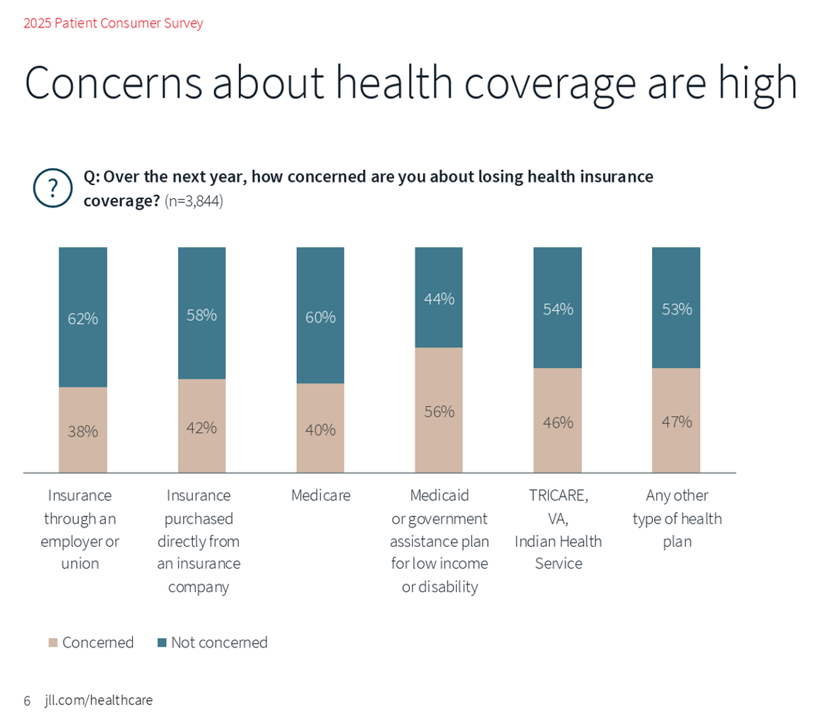HealthPopuli.com – Read More
The idea of “hospitality” in health care is not new, but the nature of how patients-as-consumers are dealing with health care choices based on what looks and feels good is changing the nature of what hospitality means in technology-enabled health care delivery, we learn from the 2025 Patient Consumer Survey conducted by JLL.
Jones Lang LaSalle Inc. (JLL) is one of the largest global commercial real estate firms with a strong portfolio of medical buildings. So it is worthwhile to track what the company is learning about health care delivery distributed both inside and outside of brick-and-mortar medical buildings.
JLL polled 4,061 U.S. adults in June 2025 to gauge patients’ perspectives as health care consumers with respect to health insurance coverage, convenience of services, satisfaction, and use of technology — especially experiences with telehealth and digital health tools.
The firm gleaned four key insights from the study:
- That access, coverage and affordability continue to challenge U.S. consumers’ health care
- Location and convenience rank top factors in choosing providers and care options — with patients residing in rural areas quite challenged for choice and access
- Technology supports improved patient experience, and,
- The first impression consumers get matters when evaluating the overall patient experience.

Here’s the lens on medical geography, and rural health citizens’ divide from care access compared with suburban patients and urban-dwelling patients. Travel time to health care facilities is challenging (that is, longer) to many more rural residents (in beige tone) than urban or suburbanites (in shades of blue).
But at the same time, note that patients residing in rural areas were less likely to have had a telehealth visit — something that feels counterintuitive on its face.

At the base of patients’ concerns, which continue to exercise folks’ health consumer muscles, is health plan coverage. These bars represent the percent of patients covered by type of plan in terms of how concerned people are about losing their health insurance coverage.
We see quite clearly that those people with Medicaid or a government assistance plan for low income or disabled people are more likely concerned about losing coverage — with people enrolled in Medicare, direct purchasers of a plan, or those insured through an employer or union less likely to be concerned about losing coverage.

Health Populi’s Hot Points: Convenience factors play a significant role in consumers’ evaluating their patient experiences, represented here by peoples’ use of Net Promoter Scores (NPSs). For example, more patients were more likely to be promoters of health care providers with convenient locations, better parking, easier way-finding, and distance between the parking and provider front door.
A provider’s use of technology planning for and during patient appointments can also bolster the consumer’s view on choice of that provider. Net-net, 51% of consumers said they’d be more likely to choose a provider that uses appointment scheduling, a patient portal for health records and physician communications, email/text follow up after an appointment, computer check-in on arrival, and online mobile check-ins all positively influenced patients-as-consumers.
These new-fangled technologies and on-ramps to patient access are all working to re-define what good looks like in health care — beyond the “care” and clinical outcomes, as it happens. For a patient, these touch-points are forms of respect, one click or screen or check-in at a time, which help people see and be seen by health care providers. These deliver on empathy, respect, and trust…..and the more patients experience them, the more these will be expected as part of the next best patient experience.
I’ll point now to the low use of chatbots in advance of appointments, registering at 5% of patient adoption/experience as of June 2025. My bet is that when JLL conducts this study in 2026 or 2027, we’ll see that digital tool line item grow to 25% or more.
On the downside, without some additional serious funding and commitment to rural health care, the access divide between urbans/suburbans and their rural cousins will exacerbate, leading to worse health outcomes for our friends and peers in less populated areas. We continue to advocate for continued investment and support for telehealth and virtual care options for all health citizens in all ZIP codes.
The post How Consumers’ Access to Telehealth Impacts Medical Real Estate and Design Decisions appeared first on HealthPopuli.com.





